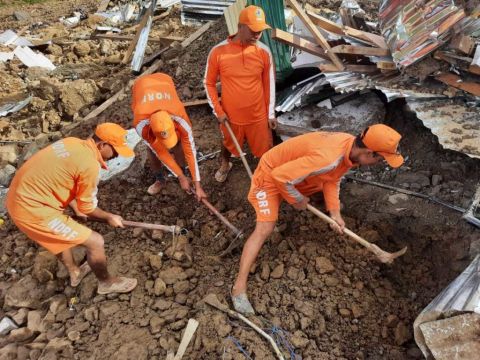Rescuers have found five more bodies after resuming clearing operations after a mudslide at a railroad construction site in India triggered by weeks of heavy downpours, officials said.
Soldiers joined more than 200 disaster response workers and police using earth-clearing equipment like bulldozers to rescue those buried under the debris in Noney, a town near Imphal, the capital of Manipur state.
But the terrain is making it difficult to move heavy equipment, said H. Guite, district magistrate, adding that he has asked for reinforcements.
Intermittent rain continues in the region where 19 bodies have been recovered so far after a hillock caved in and buried the railroad project area, Guite told The Associated Press.

Lt Gen R.P. Kalita, head of the army’s eastern command, visited the site.
He said 13 army soldiers and five civilians have been rescued from the debris of the entirely swept away railroad station, staff residential quarters and other infrastructure that was being built in the area.
The army also has set up a medical post at the site to help those found alive, Mr Kalita said.
Eighteen people with injuries have been taken to hospital, said Mr Guite.
He put the number of people still unaccounted for at around 50.
A flowing river has been blocked by the debris, creating a dam-like structure in the area, he said.
People living nearby have been asked to move to safe areas, media reports said.
Ten of the confirmed dead were members of the Territorial Army.
Because of a decades-old insurgency seeking a separate homeland for ethnic and tribal groups in the area, army personnel were there providing security for the railway officials.
Most of those carried off in the mudslide were sleeping when it hit the area early on Thursday.
Some survivors recalled being swept down by the gush of the hill debris, The Times of India daily cited Daichuipao, a resident, as saying.
Prime Minister Narendra Modi said he reviewed the situation with local authorities.
“Assured all possible support from the Centre (federal government),” he tweeted.
Continuous rainfall over the past three weeks has wreaked havoc across India’s northeast — which has eight states and 45 million people — and in neighbouring Bangladesh.
An estimated 200 people have been killed in heavy downpours and mudslides in states including Assam, Manipur, Tripura and Sikkim, while 42 people have died in Bangladesh since May 17.
Hundreds of thousands have been displaced.
Scientists say climate change is a factor behind the erratic, early rains that triggered the unprecedented floods.
Monsoon rains in South Asia typically begin in June, but torrential rain lashed northeastern India and Bangladesh as early as March this year.
With rising global temperatures due to climate change, experts say the monsoon season is becoming more variable, meaning that much of the rain that would typically fall throughout the season arrives in a shorter period.







